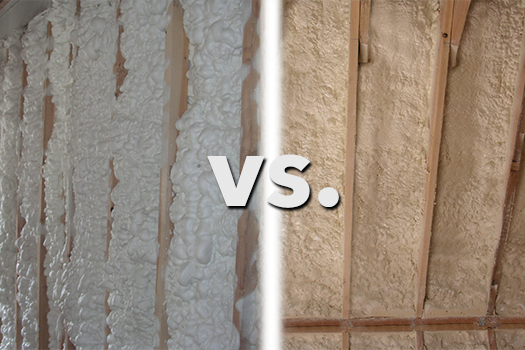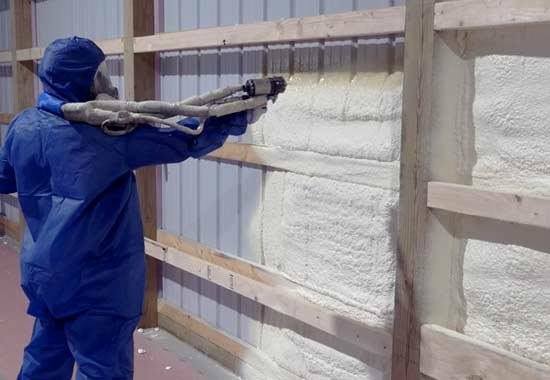Spray foam insulation is widely used in homes and buildings for its insulating properties and energy efficiency. However, once installed, it goes through an off-gassing process that’s important for homeowners to be aware of. Let’s review what spray foam off-gassing is and what you need to know about getting this insulation installed.
All About Spray Foam Insulation and Off-Gassing
What is Spray Foam Insulation?
Spray foam insulation is a type of building insulation material that is used to seal gaps and create an airtight barrier within a building’s walls, ceilings, and floors. It is a versatile and effective insulation material that can provide several benefits when properly installed.
The Two Types of Spray Foam Insulation
An insulation contractor can offer two types of spray foam insulation, open-cell and closed-cell. Open-cell spray foam is more lightweight and pliable, thus excellent for areas that need a little flexibility. Conversely, closed-cell foam is denser and more rigid; hence, it offers a higher R-value (insulation measurement) which is ideal for more demanding environments.
The Purpose and Advantages of Using Spray Foam Insulation
Aside from excellent energy efficiency due to the superior seal it provides, spray foam insulation also offers these advantages:
- High Insulating Effectiveness: Spray foam insulation has a high R-value, which means it provides excellent thermal insulation, helping to keep indoor spaces comfortable and energy-efficient.
- Air Sealing: One of the most significant advantages of spray foam insulation is its ability to create an airtight seal. It can effectively seal gaps and cracks in a building’s envelope, reducing air infiltration and heat loss.
- Moisture Resistance: Closed-cell spray foam is highly resistant to moisture, making it a good choice for areas prone to water intrusion, such as basements and crawl spaces.
- Sound Insulation: Open-cell spray foam can provide sound insulation properties, reducing noise transmission between rooms.
- Longevity: Properly installed spray foam insulation can last for many years without significant degradation.
The Off-Gassing Process in Spray Foam Insulation
Post-installation, spray foam insulation undergoes a reaction that may cause the emission of VOCs (Volatile Organic Compounds) leading to a process called off-gassing.
What is Off-Gassing?
Off-gassing is the natural process where a solid or liquid releases gas. In regards to spray foam insulation, off-gassing would refer to the emission of chemical fumes during and after the curing process.
Factors Influencing the Off-Gassing Duration
Several factors can influence how long the spray foam insulation off-gas process takes to complete. One of these is the type of foam used; low VOC foams generally produce less gas and therefore have a shorter occupancy time. The workmanship and the indoor temperature, as well as humidity, can also considerably affect the overall off-gassing time.
How Long Does Spray Foam Insulation Off-Gas?
There is no one-size-fits-all answer to this question. Instead, the time can range anywhere from a few hours to many weeks and is likely dependent on the previously discussed factors.
The spray foam we use here at Cincinnati RetroFoam requires 24 hours for the off-gassing process to end post-installation.
Variables That Can Prolong Off-Gassing Time
Several factors can lead to prolonged off-gassing from spray foam insulation. Thicker applications, higher-density foam, and closed-cell foam all tend to be off-gas for longer periods. Using foam with higher blowing agent content also increases off-gassing time. Additionally, colder temperatures and inadequate ventilation can slow the rate at which gasses dissipate from the foam. Ensuring proper thickness, selecting the right foam formulation, providing ample ventilation, and allowing adequate time for curing, especially during colder weather, can help minimize prolonged off-gassing issues with spray foam insulation.
Safety Considerations with Off-Gassing
For safety reasons, it’s important to vacate the property while the foam cures and off-gasses. It’s also recommended to consult with a qualified insulation contractor about the post-installation procedures. While off-gassing may sound unfamiliar or even dangerous, there’s no need to worry. Professional installers will give clear directions about what you need to do during the off-gassing process. Once this process is complete, your spray foam insulation will work for decades providing increased comfort throughout your home. This is an entirely safe material that gives homeowners a multitude of benefits when it comes to temperature regulation.
Look to Cincinnati RetroFoam for Your Insulation Needs
At Cincinnati RetroFoam, we take pride in our commitment to providing the Greater Cincinnati area with top-quality insulation solutions. With years of experience in the industry, our team is dedicated to making homes and businesses more comfortable, energy-efficient, and environmentally friendly.
We are passionate about helping our customers achieve greater comfort and energy savings through the power of insulation. Our mission is to create healthier, more sustainable living and working environments for the community we love. Whether you need spray foam, blown-in, or injection foam insulation, trust us to provide impeccable workmanship and quality customer service. Request your free quote today to get started.


